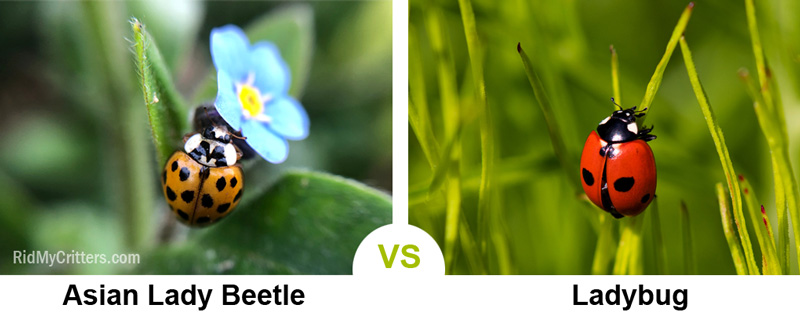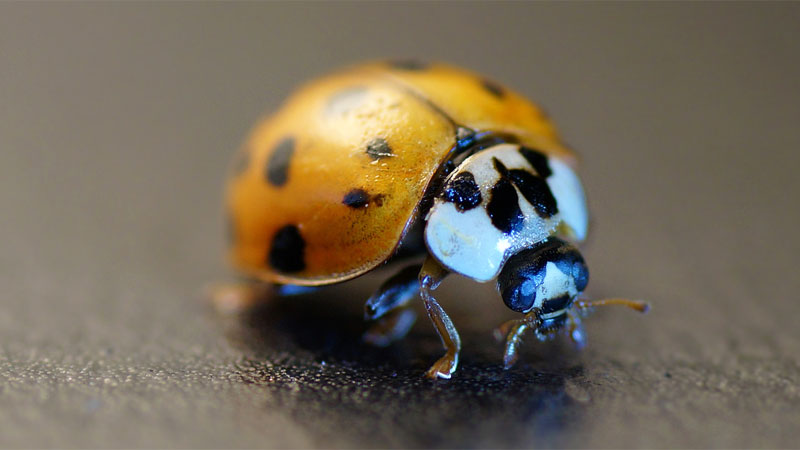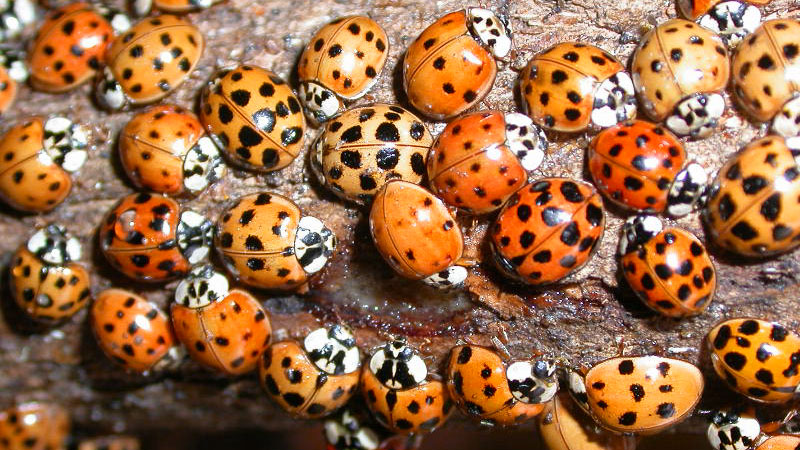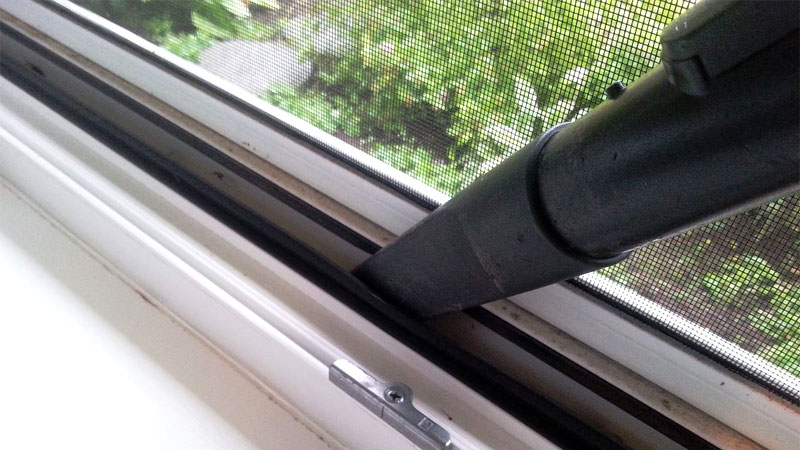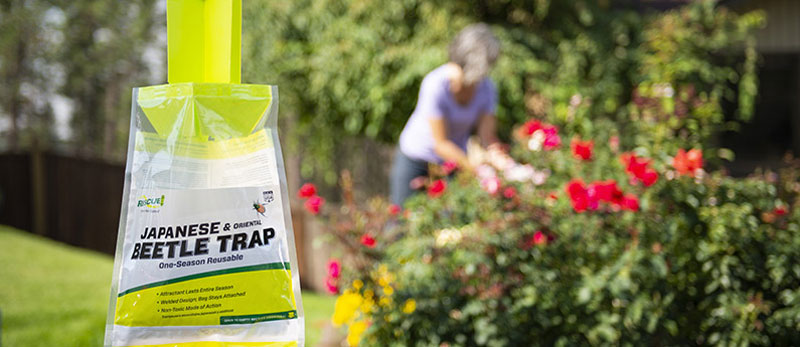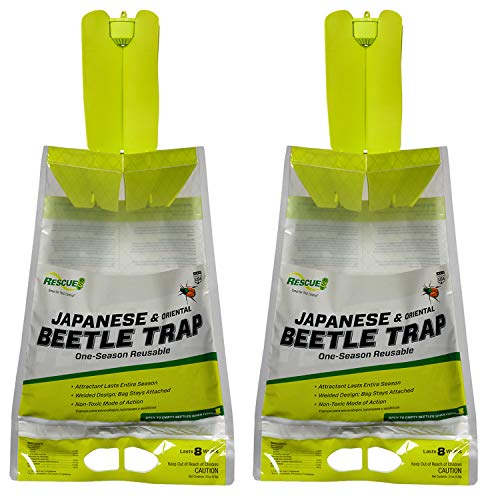One evening, you happen to notice a ladybug in your home. After a few minutes, you spot another one, then another. They seem to be gathering on the windows and around the lights. Upon further inspection, you also notice they look a little more pale than normal.
Contrary to what you might’ve been told, these aren’t “malebugs” (i.e. male ladybugs) at all, but a surprisingly common pest called the Asian Lady Beetle.
Often referred to as Japanese ladybugs by gardeners, these cute little critters are generally despised, unlike other ladybugs. But what are they exactly, and is their reputation warranted? Even more important, how do you get rid of an Asian lady beetle infestation?
Getting to Know Asian Lady Beetles
The term Asian lady beetle might be totally new to you, or you might have heard someone mentioning them before, but just what are they, anyway? And what is it about these critters that has so many people up in arms? Let’s take a closer look at these attractive but rarely wanted pests.
Asian Lady Beetles vs Ladybugs
If you’ve visited our site in past, you’ll know that comparisons are usually the last thing we discuss before elimination. However, Asian lady bugs require an exception. Why? Because they’re actually a species of ladybug called Harmonia axyridis.
Understanding Coccinellidae
Ladybugs (AKA lady beetles or ladybirds) are known in the scientific community under the family name Coccinellidae. The term ladybug itself is an American adaptation of the English nickname ladybird (originally “our Lady’s bird”, in reference to the Virgin Mary.
While we colloquially use the term “bug” to refer to a wide range of critters, true bugs belong solely to the order Hemiptera. This is the reason the Asian lady beetle is never referred to as the Asian ladybug (even though this causes some confusion).
There are more than 6,000 species of Coccinellidae, most of which have spots and are round or elliptical in shape, and are usually considered beneficial or even crucial allies in agriculture.
However, several species, such as the Mexican bean beetle, potato ladybird, squash beetle, and Asian lady beetle, are problematic and often harmful to the agricultural community.
Distinguishing Asian Lady Beetles (and Their Many Names)
Asian lady beetles are commonly referred to as Japanese lady beetles (or Japanese ladybugs) by gardeners. They’ve also earned the nicknames Halloween ladybug, harlequin ladybug, Asian beetle, and multicolored Asian ladybug due to the incredible variety of colorations within the species.
Most often, they range from tan to orange or pale red but lack the vibrant red tones of common ladybugs. The number of black spots also varies greatly, ranging from none to as many as 22. On occasion, the colors may even be reversed, giving them a black body with colored spots.
And yes, just like humans, these diverse aesthetic variations are all within a single species. In fact, the one feature all Asian lady beetles share is a black W or M shape on the white spot behind their heads.
How Asian Lady Beetles First Arrived
The United States Department of Agriculture (USDA) is known for making some terrible mistakes since its inception. Trying to employ Asian lady beetles as a biological control agent was certainly among them.
In 1916, the organization imported large numbers to be introduced in California, Connecticut, Georgia, Louisiana, Maryland, Mississippi, Pennsylvania, South Carolina, and Washington to combat ongoing aphid issues.
While these beetles bred and migrated throughout most of the country, it wasn’t until the 1980s when a large swarm was discovered in New Orleans. While the reason for this sudden surge is unknown, it’s believed to have been caused by a contaminated shipment.
Asian Lady Beetle Life Cycle
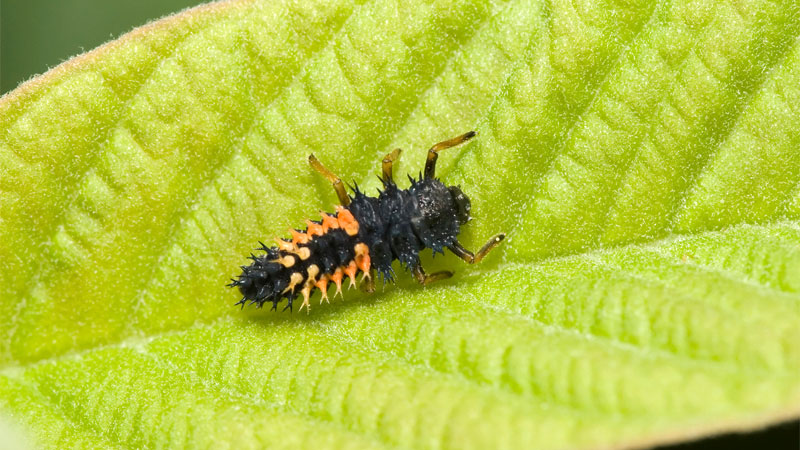
These lovely pests take three to four weeks to develop, but the adult beetles can live up to a year. Their eggs are tiny yellowish ovals laid in clusters of around 20. The female lays these clusters on the undersides of leaves, especially crops or trees that have infestations. After approximately three days, they hatch.
The larvae are tiny, measuring only 5/32 inches in length and are a charcoal to black color. They spend the next two weeks or so feeding primarily on aphids and scale insects before entering the pupal stage. This stage takes one to two weeks, during which time the 4/16-inch long orange to yellow pupae develop into adults.
If conditions are right, the adults will emerge, measuring approximately ⅜ inches. Unlike common ladybugs, they’re able to survive the winter, usually seeking shelter in warm places such as your home.
Do Asian Lady Beetles Bite?
Unlike regular ladybugs, Asian lady beetles do indeed bite. However, the bite is small and you might not even notice it barring an allergic reaction.
Health Risks
Unlike most pests, Asian lady beetles don’t carry any diseases or parasites. In fact, they actually help eliminate a number of tiny insect pests, such as aphids, mealybugs, or scale.
Thus, they pose no known threat to humans, even when they do bite. At worst, they might set off an allergic reaction in sensitive individuals, and this is most often caused by contact with their defensive secretions.
As for animals, there are plenty of old wives’ tales about these critters being dangerous to pets. This is simply unfounded, and the worst cases reported have been a dog with an irritated mouth or belly ache after eating a small swarm – which is an extremely rare possibility.
Related: Are Ladybugs Poisonous?
Are Asian Lady Beetles Bad for the Garden?
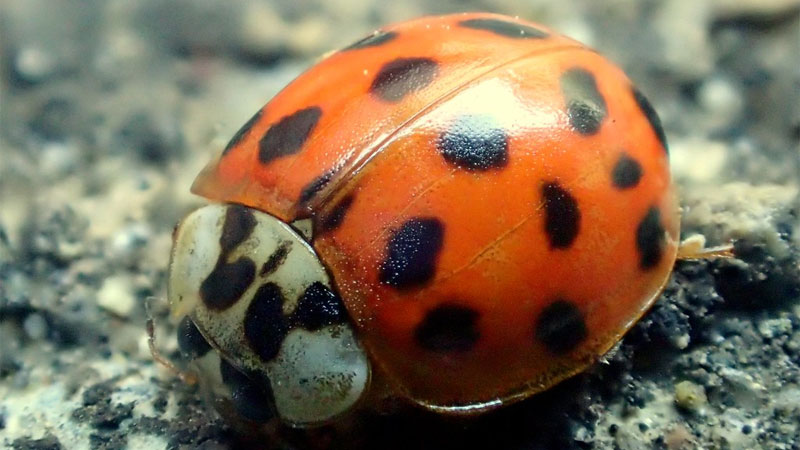
Talk to most gardeners and they’ll tell you that the Japanese ladybug is wonderful against piercing insects, but can also devastate crops when there’s a lack of food. This is due to the similarity in names with the Japanese beetle (Popillia japonica), a nasty piece of work that’s become a major plague in the US. But are these ladybugs really that bad?
The truth is both yes and no. Asian lady beetles won’t harm crops and actually prey on a lot of common garden pests. In fact, a single harlequin can devour between 600 and 1,200 aphids as a larva and 90 to 270 aphids per day as an adult.
Unfortunately, they’re also known to attack native ladybugs, which tend to be slightly smaller. From an environmental standpoint, this has been devastating in many countries, including the US. However, they’re perfectly safe to employ in your garden or farmland with that one nasty footnote in mind.
So Why Are They Pests?
Japanese lady beetles cause two major issues that can drive the average person bonkers.
- First of all, they hibernate during the winter instead of dying off, which means they’re likely to invade your home, garage, or RV seeking warmth. As they have a natural defensive secretion that leaves an unpleasant odor. Thus, your nose might discover an Asian beetle infestation well before your eyes do.
- Second (and perhaps even more importantly), their secretions can leave sticky yellow stains. Imagine the “tobacco” a grasshopper donates when you try to hold it.
Now imagine a cute little ladybug leaving a smaller yellow equivalent that smells foul. Can you picture it? Good, now picture what dozens or even hundreds of these critters can do to your walls and furniture.
You might not even notice where they’re all hiding until the furnace kicks in, waking up the little intruders and encouraging them to explore your home. Since they’re attracted to light, it’s not uncommon for them to swarm windows or lighting fixtures, leaving their nasty residue behind.
Why Are There So Many Asian Beetles in My House?
Following up on the last section, let’s take a quick look at why so many will appear indoors at once.
During the warm months, Asian lady beetles will actively hunt for food anywhere plants might be. Unlike most ladybugs who tend to travel alone or in small swarms, this species can have swarms with as many bugs as a decent locust swarm.
Come autumn, the weather begins to cool off and common North American species begin to die off, but not the Asian lady beetle. Instead, the swarms begin looking for shelter.
If they find cracks around windows or crevices in your home’s exterior, they’ll make their way inside. As they’re attracted to light, brightly colored or lit houses are more likely to be invaded than darkly colored, unlit houses. They’ll then set up a winter-long sleepover in wall voids or other hidden spaces.
Getting Rid of Asian Lady Beetles
Now you know the Asian ladybug isn’t dangerous, but its defensive secretions can trigger allergies, bear a strong scent, and stain your home. So how do you eliminate them from your home or RV? And what do you do if you want them out of your garden (at least temporarily)?
Prevention is Key
Show us one article on a critter that invades homes where we fail to mention exclusion, and we’ll ask what site it came from. Exclusion is the single greatest weapon in the pest control arsenal, and it’s something anyone can do.
Pick a day and grab some caulk, then make your way around the outside of your home. Look for cracks and holes along:
- Door and window frames
- The foundation
- Siding or outer wall damage
- Eaves and gutter attachment points
- Vents and chimney attachment points
Repair any damaged window screens and/or replace them with storm windows for the winter. Check your basement and put mesh at any place where pipes or wires enter the house to seal potential gaps.
Back outside, ensure any mulch or protective groundcovers are pulled at least six inches away from the house. You’ll also want to trim back any plants that are touching the walls. Be sure that your gutters are kept clean, both to discourage nesting and to prevent potential ice dams during the winter.
Asian lady beetles will often congregate where there were previous infestations, so sealing your home, garage, or other structure can go a long way towards preventing an infestation – and not just by harlequins.
Read Also: 6 Ways to Get Rid of Boxelder Bugs
Control Methods to Avoid
Part of the reason Asian lady beetles are considered nuisance pests is their smelly secretion, so you want to avoid any methods which can release this odor. This includes electric bug zappers, squishing/swatting, or sweeping.
Removing From the Home
In the unfortunate event you see an Asian lady beetle in your home and it has company, you’re in for an uphill battle. The good news is that they don’t lay eggs indoors, so once you kill the adults, they’re gone.
The bad news is, their odor will attract future generations, so be sure to give your home a good scrubbing to remove any secretion residues.
#1 – The Mighty Vacuum
Do you know how they often say a clean home is a bug-free home? Well, your vacuum cleaner may just be the greatest weapon in your arsenal.
Simply turn it on and suck the cute little monsters away before they have time to react. Sure, the canister or bag might smell, but those are easily disposed of – preferably in a receptacle at the far end of your property.
Note that some people like to attach a stocking to the vacuum tube using a rubber band. This may or may not prevent the container from smelling.
- POWERFUL SUCTION: Deep-clean carpets and tackle bare floors with multi-surface...
- LIFT-AWAY FUNCTIONALITY: Detachable pod for cleaning under furniture or detach...
- ANTI-ALLERGEN COMPLETE SEAL TECHNOLOGY: Works with a HEPA filter to trap dust...
#2 – Chase Them Outside With Happy Smells
One man’s trash is another’s treasure, and Asian lady beetles hate a lot of the smells we find endearing. On a fairly warm day (they prefer 65 degrees or warmer), open a window and start laying out some sweet scents to drive them outside. Some great options include:
- Bay leaves (preferably fresh)
- Citronella
- Citrus
- Cloves
- Garlic
- Peppermint
You can also multitask by using lemon-scented cleaning products to remove their stench while driving them away from yours. These can be store-bought (such as Pledge) or homemade (lemon juice and olive oil make a great natural polish/preservative for older wood furniture).
It should be noted that scientists have proven camphor is an effective repellent for these little pests. While the wood itself isn’t cheap, the wonderful scent can be purchased in many forms. You may also be able to find small blocks, similar to cedar blocks, if you look hard enough.
#3 – Light Traps
While bug zappers are a big no-no, there are blacklight-based light traps that capture the beetles without electrocuting them. You’ll need to put them in rooms where all other lights are blocked out, but they can prove quite effective.
- INDUSTRIAL STRENGTH UV TRAP: Catchmaster's Insect Light Trap is highly...
- POWERFUL UV LIGHT ATTRACTANT: The power of direct UV light exposure is utilized...
- NON-TOXIC AND SAFE: The outdoor and indoor fly trap is ready to use and...
#4 – Glue Traps
The classic sticky trap will also work against harlequins. Unfortunately, the trick is often getting them to fly or land onto one. Put glue boards, glue strips, or sticky fly traps where the lady beetles are congregating.
We recommend having a bright light there to further draw them in. The best part about these traps is that it not only kills the Asian lady beetles, but it also catches the secretions so you can dispose of both at once.
- READY TO USE: Mouse, Rodent and Insect glue traps are pre-scented and are...
- YEAR ROUND PROTECTION: Catchmaster glue traps are safe, non-toxic and no-mess....
- HOME & FAMILY SAFE: Designed to help you keep your family protected and safe...
#5 – Soapy Water
Fill some bowls with water and a few drops of Dawn dish soap, then place them somewhere they’ll reflect light. The beetles will fly in and drown.
#6 – Diatomaceous Earth (DE)
This powder is a valuable ally against all sorts of small critters. Simply sprinkle some food-grade DE on any surfaces the beetles like to land, and the crushed microscopic fossils will slice them open and cause them to die of dehydration.
Be warned that while safe for use, it can prove an irritant if inhaled or a smaller pet walks on it, so use it out of reach of any kids or pets.
- Natural Product - Composed of 4lbs of 100% ground freshwater diatomaceous earth...
- OMRI Listed - Listed with the Organic Minerals Research Institute, a non-profit...
- Powder Duster Included - Powder duster in the bag for easy and efficient...
While control is essentially the same for an RV as it is for a house, you may find some additional difficulty in properly sealing away all entry points. This is especially true if you aren’t in a more-or-less permanent location where you can seal the underside.
In such cases, do your best and try to build a fine mesh wood-framed barrier around the open bottom of the camper that can be folded up and stored when you’re on the go.
Outdoor Remedies
#1 – Bag Trap
This outdoor trap uses a special pheromone scent to lure Asian lady beetles away from plants. Once they get close enough, they fly into the funnel and are trapped by the bagful. No poisons or chemicals are used, so you can use it in your garden without having to worry about harming the environment or your family.
- Catch Beetles by the Bagful – Japanese and Oriental Beetles are invasive...
- How It Works– Once attracted by the pheromone scent, Japanese beetles fly into...
- Reusable – The attractant cartridge included with this trap will last an...
#2 – Pesticides
There are plenty of pesticides out there that’ll work on Asian lady beetles, but be warned that they’ll also affect beneficial insects. Choose one that contains bifenthrin, cyfluthrin, cypermethrin, deltamethrin, or permethrin.
- Kills Lady Beetles When Spray Dries - The spray will kill once completely dried...
- Odorless Formula - Odorless and non-staining formula will not cause damage to...
- EPA Registered - Registered with the Environmental Protection Agency (No. 3-11)...
#3 – Plant Chrysanthemums
Ladybugs don’t like mums and will avoid them, making this option a physical barrier you can enjoy.
#4 – Recruit Natural Predators
Even though Asian beetles are an invasive species, they still have plenty of local enemies. Insectivore birds are top of the list and will happily whittle down an Asian lady beetle population. Larger beetle species are also known to feed on the harlequin.
Alternatives to Killing
Finally, there are a couple ways to avoid an infestation without tossing the baby with the bathwater.
Harlequins help the garden but want shelter in wintertime, so pay them for their service by purchasing a ladybug house or build one yourself. These work just like birdhouses and are a humane (and mutually beneficial) solution.
Keeping pests away from your home by creating a dead zone will also help. This is a barrier around your foundation where there are no plants. Use a barrier insecticide to help ensure no insects can cross the zone.
Without a food source, the harlequins will likely avoid the area. Just know that they might eat any insect dumb enough to try and cross this zone, poisoning them as well.
- How to Get Rid of Hawks - March 8, 2024
- How to Get Rid of Pill Bugs (Rolly Pollies) - March 1, 2024
- How to Get Rid of Groundhogs (Woodchucks) - February 5, 2024

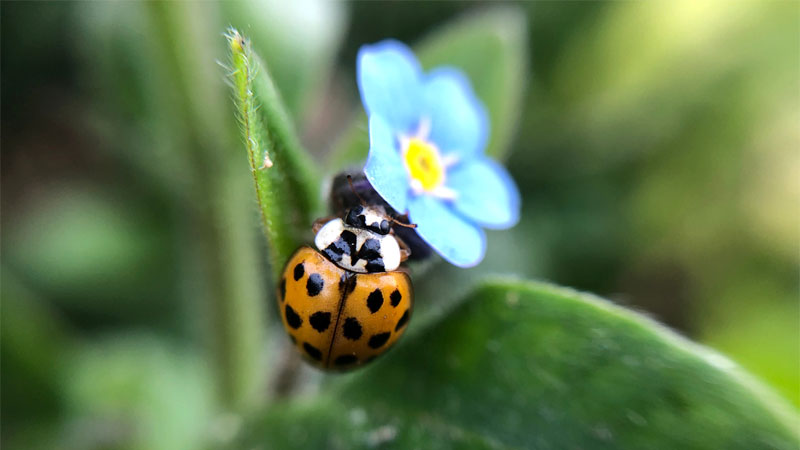
 Just tell me how to get rid of ’em.
Just tell me how to get rid of ’em.